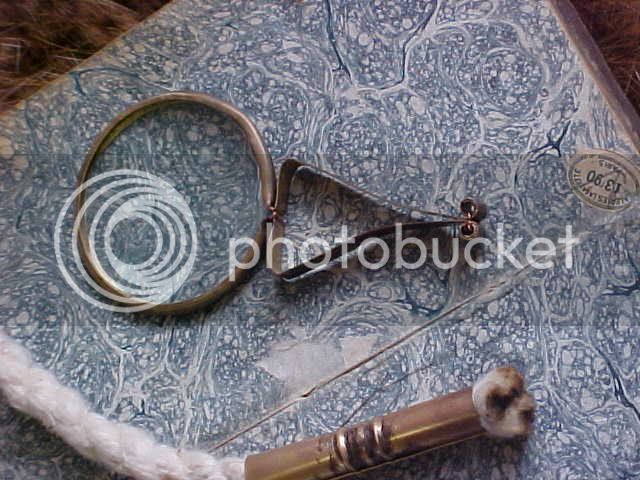
Here is the information that I found in the Museum of the Fur Trade Quarterly :
Burning Glasses
By "The Engages"
Burning glasses - small hand-held magnifying glasses used to start fire were a common item of trade on the frontier from very early times. George Quimby lists them as one class of artifact common in Great Lakes sites trhoughout the Historic Period. In his discussion of Indian trade material in the Wisconsin State Historical Museum, Charles E. Brown wrote that the burning glasses furnished to the Wisconsin Indians "were circles of glass of small diamoter set in a circle of wire and furnished with a short handle of the same material."
These glasses did not come to the wilderness simply to please the Indians. In fact, the Indians may have acquired an interest in them by watching white men employ them to light their pipes or make fire. Until American matches became readliy available in the 1860's everyone used flint and steel. If sunlight was available, the burning glass saved time, scratched knuckles and the inconvenience of using tinder. On his trip over the trail to California in 1849, Goldsborough Bruff and at least one fellow-travler used glasses as pipe lighters. One day a Pawnee Indian seized the glass the other man was using and ran off with it.
Burning glasses were standard items in the early trade of the Hudson's Bay Company. The Indian word for them was included in James Isham's Indian vocabulary collected at Fort Churchill in the early 1740's. They were regularly invoiced to the Bay posts in the 1750's and are listed in the Standard of Trade for York Fort in the 1760's. Years later, Isaac Cowie, Hudson's Bay trader on the western plains, 1867-74, wrote:
In sunshine, the burning glass quickly sets fire to touchwood or tinder, but for general service the flint and steel was the main reliance, and the natives were wonderfully adept in their use, making the sparks fly like a blacksmith's forge. But till the art was acquired, a novice often uses up a lot of skin and fiery language before getting a light.
He went on to observe that in "those 'matchless' days ... flint, steel and tinder ... were the only means of striking a light, unless during sunshine with a burning glass."
The incomparable James Willard Schultz repeated a Blackfoot hunting story, told him in 1877, in which an Indian mentioned filling his black stone pipe and lighting it with a "sun glass." Eventually, the burning glass was simply a child's toy and few people today would think of applying that name to a magnifying glass.
Apparently, no special model of simple burning glass was developed for the Indian trade. At any particular period the glasses sold by the traders were simply the cheap style used by people everywhere. In the seventeenth and eighteenth centuries they were convex lenses 1 1/2 inches or even less, in diameter in their copper frames held together by fine wire bindings. As early as 1807 the Hudson's Bay Company was ordering 1 1/2-inch glasses in horn cases which provided much better protection when being carried. These orders were continued until the very early 1860's when the specifications were changed to metal cases of the same pattern.
The simple burning glasses we have discussed here were separate and distinct from the burning glasses permanently installed in the lids of round or oval metal tobacco boxes. These outfits were sold for nearly a century by the Hudson's Bay Company and also to a limited extent by the U.S. Office of Indian Trade. They were illustrated and described in detail in "Iron Tobacco Boxes," Museum of the Fur Trade Quarterly, Spring 1973.
YMH&OS Jim Kimpell





